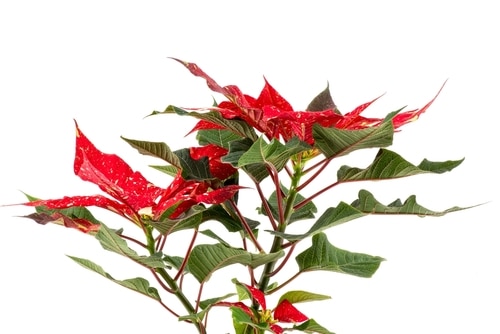Poinsettias are native to Mexico and Central America. The plant was named after Joel Robert Poinsett after he introduced the plant to the United States during the 1800s. Today, poinsettias are one of the most popular Christmas decorations, and their trademark red leaves grace the homes and businesses all across the country. But can poinsettias be outside plants?
In addition to their vibrant color, poinsettias are also known for their distinctive shape. The leaves of a poinsettia are arranged in a spiral pattern, which gives the plant a unique appearance. Let’s look at whether the plants can be grown outdoors.
Can Poinsettias Be Outside Plants?
Poinsettias are tropical plants, so they can only tolerate being outside if the weather is warm enough. The ideal temperature for them is between 60 and 80 degrees Fahrenheit. However, they can also tolerate temperatures as low as 50 degrees Fahrenheit.
So, if you live in an area with mild winters, you can probably keep your poinsettias outdoors all year round. Just make sure to bring them inside if the weather starts to dip below 50 degrees.
How to Care For Poinsettias Outside?
If you decide to keep your poinsettias outdoors, there are a few things you need to do to make sure they stay healthy.
Location
When it comes to growing poinsettias, paying attention to your plant’s location is essential. They thrive in sunny spots with at least six hours of direct sun each day.
The soil should be well-drained and rich in organic matter; if it’s heavy or clay-like, mix in some sand or perlite to improve drainage. To help retain moisture and keep roots cool, apply a thick layer of mulch around the base of the plant.
Watering
Poinsettias are drought-tolerant and only need watering when the soil is dry to the touch. During the summer, you may need to water them once or twice a week; in the winter, they can usually get by with just one deep watering per month.
When you water your poinsettias, make sure to do it in the morning when the leaves have time to dry before nightfall.
Fertilizing
Poinsettias are light feeders and only need to be fertilized once every two weeks during the growing season. A balanced fertilizer (one with an N-P-K ratio of 20-20-20) is a good choice. Apply the fertilizer according to the package directions.
Pruning
As your poinsettias grow, they will need pruning occasionally to maintain their shape, and the best time to do this is early spring before new growth begins.
Start by removing any dead or damaged leaves, then trim the remaining leaves until they are about 6 inches long. Be careful not to cut into the woody part of the plant; if you do, it will be difficult for the plant to recover.
Pests and Diseases
Poinsettias are relatively resistant to pests and diseases, but they can still be affected by them from time to time. The most common pests that affect poinsettias are mealybugs, whiteflies, and spider mites. These pests can cause the plants’ leaves to turn yellow and drop off.
The most common disease that affects poinsettias is root rot. This disease can happen if the plant is overwatered or if the soil is too dense and doesn’t drain well. If you think your plant has root rot, look at the roots, if they are brown and mushy, it’s time to replant in fresh, well-drained soil.
When to Bring Poinsettias Inside?
Even if you live in an area with mild winters, you should bring your poinsettias inside before the first frost. This is typically around the end of October or the beginning of November.
When you bring them inside, ensure to put them in an area with a lot of sunlight. A south-facing window is ideal. You should also continue to water and fertilize them regularly.
What to Do With Poinsettias After Christmas?
Are you wondering, how long do poinsettia last? Once Christmas is over, you can keep your poinsettias indoors until the weather warms up again. You can start to acclimate them from being outdoors around March or April when the weather starts to get warmer.
To do this, put them in a shady spot outdoors for a few hours each day.
Once the weather is warm enough, you can plant them in your garden and they will likely bloom again next winter.
Final Thoughts
Poinsettias are beautiful plants that make a great addition to any home or garden. If you live in an area with warm winters, you can keep them outside all year round.
With little care, your poinsettias will thrive both indoors and out. Just remember to bring them inside if the temperature starts to dip below 50 degrees Fahrenheit. And, if you want your plants to bloom again next year, don’t forget to provide them with 12 hours of darkness each day starting in mid-October.

